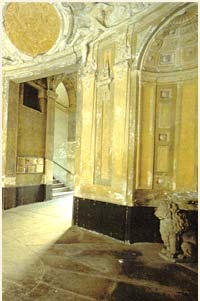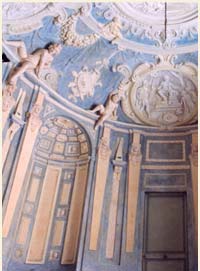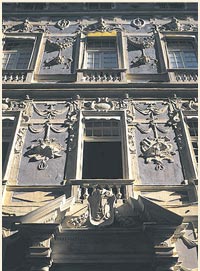The restoration works, started in the month of March 2000, began with the recovery of the polychrome stucco decorations in the atrium. The plastic decorations attributed to Giovanni Battista Castello il Bergamasco were completely covered by massive layers of lime- and tempera-base colorings, oxidized, which dulled the forms, erasing details and features and concealing the original color. The more recent layer of color, commissioned by Andrea Podestà in the second half of the XIX century, appeared loose, very blackened and partially detached.
Removal of the colorings through the use of a scalpel brought to light wide "brushstrokes" with an almost dry brush in the light-blue backgrounds, used to create the look of a transparent veil. Here the paint touch-ups with water-color glazing were aimed primarily at fixing up the abrasions and the colorless spots not attributable to the original technique.
A fine mortar with a lime and marble powder base was used to point the surfaces where the old touching ups had been removed.
As mentioned by Federico Alizeri, the stucco reliefs in the atrium and on the elevation of Palazzo Lomellino, except for the repeated colorings and the inevitable reconstructions due to structural changes, especially on the façade, have stayed considerably compact and cohesive through time.
The recently completed restoration of the decorations of the façade on Strada Nuova reveals the original color scheme, consisting mainly of the contrast between the almost natural color of the stucco and the slate-blue of the backgrounds: scientific investigations have revealed that it is a "marmorino" plaster finish with the addition of "Lamp black", a pigment of organic, mineral and natural origins, obtained by burning oils, greases and petrol in an air-free environment, a material that has been used for painting since ancient times.
The works carried out in the XIX century by Andrea Podestà, who purchased the building in 1865, were basically limited to repainting the façade, as Alizeri mentions (1875 page 190): "lightened the front, a bit darkened by ancientness".
The fadings observed on the stuccos and on the tempera-based paintings found on the mono-chromatic cornices of the inlaid bays, may in fact belong to these works commissioned by Podestà.
During the first on-site inspection, several break-offs were noticed while mapping the state of the preservations, especially near the stringcourses. These probably resulted from vibrations caused by fragments of a bomb that once hit the façade and to draining of rainwater.
Another cause of the poor conditions was the almost uniform laying of a yellow-orange tempera, which penetrated into the first surface layer and led to a blotchy staining: the more the surface was compromised by the loss of the smooth coating, the more stubborn was the problem.
Reliefs and bay profiles were almost evenly covered by a layer of dust and carbon deposits which distorted their appearance by dulling the forms; in addition, diffused erosion phenomena of the relief surfaces were observed, especially in the festoons on the second floor and markedly in the entire fascia at the right-hand corner, as well as numerous fractures of the forms caused by oxidation of the internal iron elements, that can be found mainly in the most overhanging sections of the fruit festoons, in the lion-shaped masks and in the panoply located at the far right of the first floor.
In many places the plaster finish was detached or had come off, or fallen from the bay profiles, stringcourses and cornices. The entire surface was cleaned through a careful washing with atomized deionized water, but only after having reinforced the aforementioned sections by injecting semi-fluid mortar.
After adding lime-based mortar to the missing sections that resulted after the removal of the damaged stuccos, the inlaid bays were treated with a glazing of suitably pigmented lime colors to give back their original neutral-slate chromatic pattern.
All stone elements of the façade were cleaned by means of the "jos" system, which consists in spraying atomized jets of water at low pressures (up to 0,2-O,4 atm) mixed with extra-fine calcium carbonate powder, while the marmoreal surface of the portal and of the small balusters was protected with a breathable single-component polymer.

The atrium of the Palazzo before the start of the restorations.

The restorations that revealed the atrium's original colors.

Detail of the façade overlooking Strada Nuova after the restoration works.
